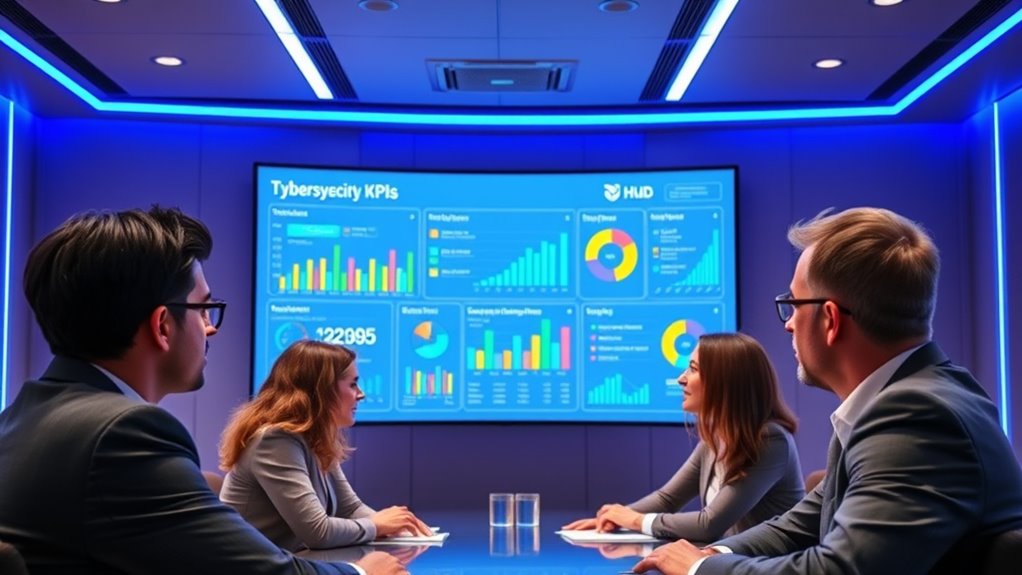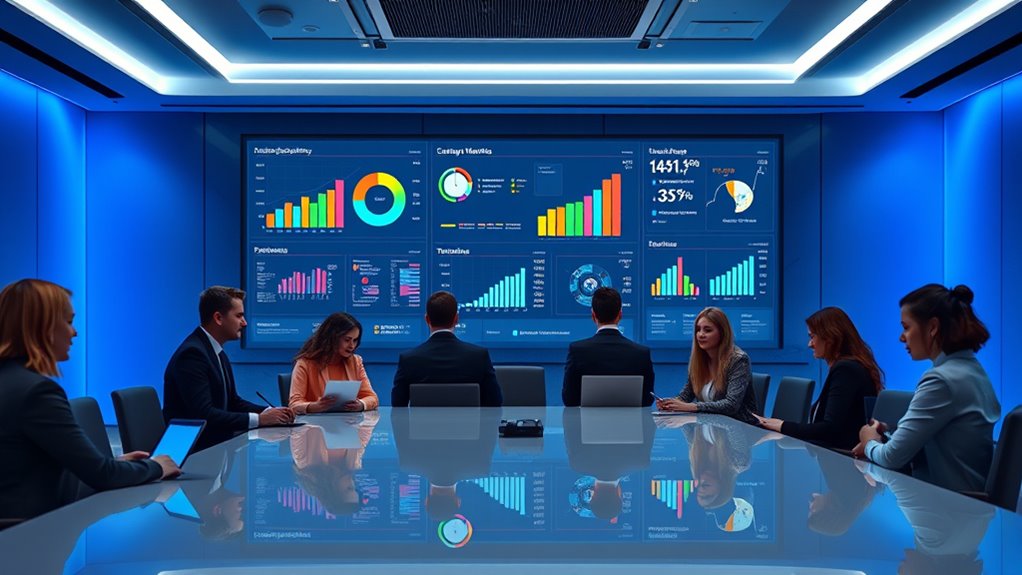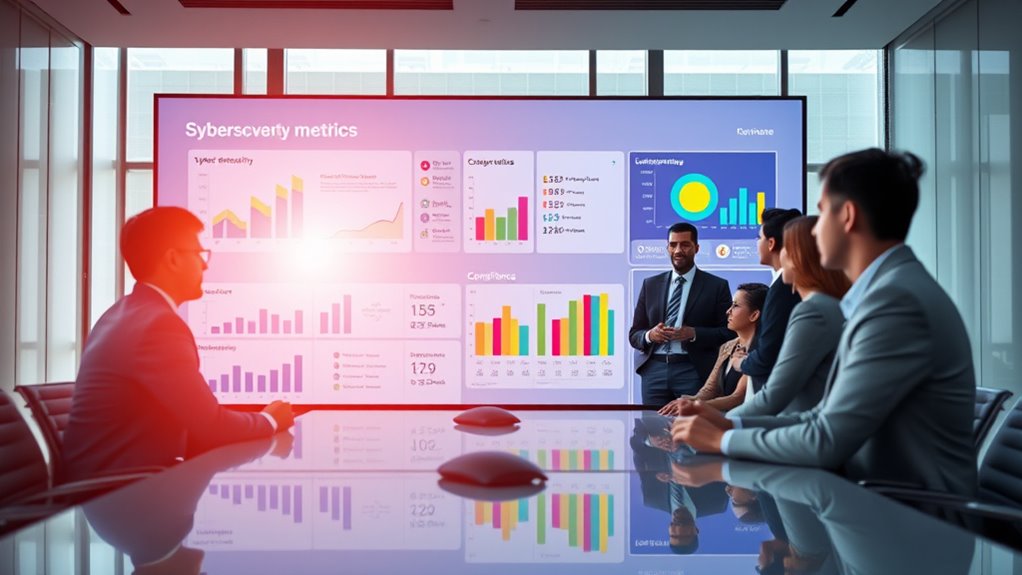To impress the board and drive real change, focus on KPIs that highlight your security posture, like security ratings above 700 and program maturity scores aligned with frameworks like NIST. Link cybersecurity initiatives to business goals using metrics such as revenue impact and customer trust. Leverage data-driven insights to prioritize risks, showcase operational automation gains, and monitor financial impacts for cost efficiency. Mastering these metrics will help you communicate value and foster strategic growth—discover how to make your cybersecurity strategy truly impactful.
Key Takeaways
- Present cybersecurity ratings above 700 to demonstrate a strong defense posture and lower breach risks.
- Use business-aligned metrics like revenue impact and customer trust to showcase cybersecurity’s strategic value.
- Highlight operational improvements with metrics such as detection response times and automation efficiency gains.
- Quantify financial impact and cost savings from cybersecurity investments to justify budgets and prioritize initiatives.
- Track board engagement levels to illustrate leadership’s commitment and accountability in cybersecurity efforts.
Demonstrating Strong Security Posture With Key Metrics

To effectively demonstrate a strong security posture, organizations must leverage key metrics that provide clear, actionable insights. Your security rating acts as a quick snapshot of your cybersecurity health, similar to a credit score. A higher rating indicates you’re less likely to face data breaches, with ratings above 700 signifying a stronger defense. The cybersecurity program maturity score reveals how well your security efforts align with frameworks like NIST, highlighting areas for improvement across people, processes, and technology. Tracking board engagement frequency shows how often cybersecurity is a strategic priority at leadership levels, fostering accountability. Additionally, system hardening and privileged account metrics help reduce vulnerabilities and access risks. These metrics collectively enable you to communicate your security effectiveness clearly and benchmark progress over time. Security Rating indicates overall security performance and supports executive decision-making. Regularly reviewing security metrics can also help identify emerging threats before they escalate into significant incidents.
Aligning Cybersecurity Initiatives With Business Goals

Effective cybersecurity isn’t just about technical defenses; it’s about aligning security efforts with your overall business goals. When cybersecurity is part of your strategic vision, it becomes a driver of growth and trust, not just a cost. Embedding security into digital transformation boosts resilience and supports market expansion. To succeed, you need to:
Cybersecurity aligned with business goals drives growth, trust, and digital resilience.
- Establish a shared language between cyber teams and business leaders, focusing on risk, revenue, and reputation.
- Use business-relevant metrics like revenue impact and customer trust to measure cybersecurity success.
- Integrate cybersecurity into decision-making processes, ensuring investments align with strategic priorities.
- Balancing technical and business metrics ensures a comprehensive view of cybersecurity’s impact across the organization. Incorporating business-relevant metrics helps translate security efforts into tangible benefits for the company.
This approach helps you demonstrate cybersecurity’s value, reduces costs from breaches, and strengthens your competitive edge. When security aligns with business goals, you open new opportunities for growth and long-term trust.
Leveraging Data-Driven Insights for Strategic Decisions

Harnessing data-driven insights transforms how organizations make strategic cybersecurity decisions by providing clear, actionable intelligence. With the overwhelming volume of alerts and vulnerabilities, you need analytics to identify high-risk issues that threaten your organization. Data-driven security filters out noise, spotlighting vulnerabilities with the highest potential impact. Root cause analysis, powered by data, helps you address underlying issues to prevent repeated attacks. This approach reduces human bias, aligning threat prioritization with your unique risk profile. Additionally, translating complex data into straightforward insights enhances communication with executives, enabling faster decision-making and resource allocation. Incorporating cybersecurity KPIs ensures that security measures are measurable and aligned with organizational goals. By leveraging precise, relevant data, you ensure your cybersecurity strategy is proactive, targeted, and aligned with your organization’s overarching business objectives.
Showcasing Operational Effectiveness and Automation Gains

Showcasing operational effectiveness and automation gains is essential for demonstrating how cybersecurity teams improve efficiency and resilience. By highlighting key metrics, you can quantify improvements in detection, response times, and resource allocation. Automation plays a crucial role, increasing threat detection rates, automating responses, and deploying patches faster. These gains not only streamline operations but also reduce human error and free up valuable staff time.
Operational metrics and automation drive cybersecurity efficiency, reducing errors and boosting threat response speed.
- Automated Threat Detection Rate: Shows how much automation accelerates threat identification.
- Incident Response Automation Ratio: Reflects how automation speeds up containment and resolution.
- Reduction in Manual Security Tasks: Demonstrates operational streamlining and fewer human errors.
Focusing on these metrics clearly illustrates the tangible benefits of automation and operational maturity to your stakeholders.
Monitoring Financial Impact and Cost Efficiency

Building on operational metrics, monitoring the financial impact of cybersecurity efforts helps you understand the true cost and value of your security program. By quantifying potential losses from cyber events, you gain insight into your organization’s financial exposure and risk appetite. Tracking the cost per incident reveals how efficiently you respond and recover, highlighting areas for improvement. Estimating the financial risks of unresolved vulnerabilities directs focus to high-risk issues, enabling prioritized remediation that reduces potential losses. Additionally, cybersecurity ROI demonstrates the effectiveness of your investments by showing cost savings and risk reduction. Quantifying and Communicating Cyber Risk Exposure and Impact Real-time dashboards and automation streamline this process, providing quick, accurate insights for board discussions. These metrics clarify the financial landscape, justify budgets, and support strategic decision-making. Incorporating business impact analysis into these metrics further enhances understanding of how cybersecurity influences overall organizational performance.
Enhancing Governance and Compliance Transparency

How can organizations guarantee that their cybersecurity governance and compliance efforts are transparent and trustworthy? The key is implementing clear metrics and reporting processes. Track board oversight and executive accountability with Key Governance Indicators (KGIs). Use compliance frameworks like GDPR and HIPAA to ensure regulatory adherence. Regularly update policies and maintain robust internal controls to detect fraud. Automate compliance monitoring with advanced tools and conduct frequent audits for transparency. Engage stakeholders actively to foster trust. Effective GRC metrics enable organizations to objectively measure and demonstrate their compliance and security posture. Incorporating visualization tools and dashboards enhances real-time insights and facilitates proactive decision-making. Conduct regular regulatory audits and risk assessments. Keep stakeholders informed through clear, concise reporting and feedback loops.
Frequently Asked Questions
How Can Cybersecurity KPIS Improve Overall Organizational Resilience?
Cybersecurity KPIs improve your organization’s resilience by giving you clear insights into how effectively you detect, respond, and recover from threats. They help you identify vulnerabilities, ensure compliance, and optimize incident response times. By tracking these metrics, you can prioritize security efforts, adapt strategies quickly, and fortify your defenses. This proactive approach minimizes disruptions, maintains business continuity, and builds a robust security posture that withstands evolving cyber threats.
What Are the Best Practices for Communicating Cybersecurity Metrics to Non-Technical Stakeholders?
You want to communicate cybersecurity metrics effectively to non-technical stakeholders. Focus on clarity, simplicity, and visuals. Use familiar language to explain risks and impacts, and employ charts or graphs with color coding to highlight trends. Keep reports outcome-based, emphasizing results and improvements. Be objective, transparent, and concise, ensuring your message aligns with business goals. By doing so, you foster understanding, drive engagement, and support informed decision-making across your organization.
How Do Cybersecurity KPIS Influence Strategic Decision-Making at the Executive Level?
You see, cybersecurity KPIs influence your strategic decisions by providing clear, measurable insights into your organization’s security posture. They help you prioritize investments, allocate resources efficiently, and justify cybersecurity budgets. With real-time data and risk metrics, you can make informed choices that align security initiatives with business goals, reduce vulnerabilities, and enhance resilience. Ultimately, KPIs empower you to integrate cybersecurity into your broader strategic planning for sustained growth and protection.
What Role Do Emerging Technologies Play in Enhancing Cybersecurity KPI Tracking?
Emerging technologies are transforming cybersecurity KPI tracking at a lightning-fast pace, making traditional methods seem like relics. You leverage centralized data aggregation, automation, and real-time updates to get instant, accurate insights. AI and machine learning analyze patterns and predict threats before they escalate, while integration with compliance frameworks guarantees you’re always aligned. These innovations enable you to monitor, respond, and adapt swiftly—drastically improving your security posture and decision-making agility.
How Often Should Cybersecurity KPIS Be Reviewed and Updated for Effectiveness?
You should review your cybersecurity KPIs regularly to keep them effective. Monthly reviews are ideal for tracking trends and making operational adjustments, while quarterly assessments support strategic decisions. Immediately update KPIs after major incidents, new threats, or tech changes. This approach guarantees your metrics stay relevant, actionable, and aligned with evolving risks, helping you respond swiftly and improve your security posture continuously.
Conclusion
By focusing on the right KPIs, you’ll naturally align cybersecurity with your business goals, revealing insights that impress the board. When your metrics reflect operational gains and cost savings, it’s no coincidence—you’re building trust and driving real change. Stay proactive with data-driven decisions and transparent governance, and you’ll find that cybersecurity becomes not just a necessity, but a strategic advantage. Ultimately, the right KPIs make it clear: your security efforts truly support your business success.









